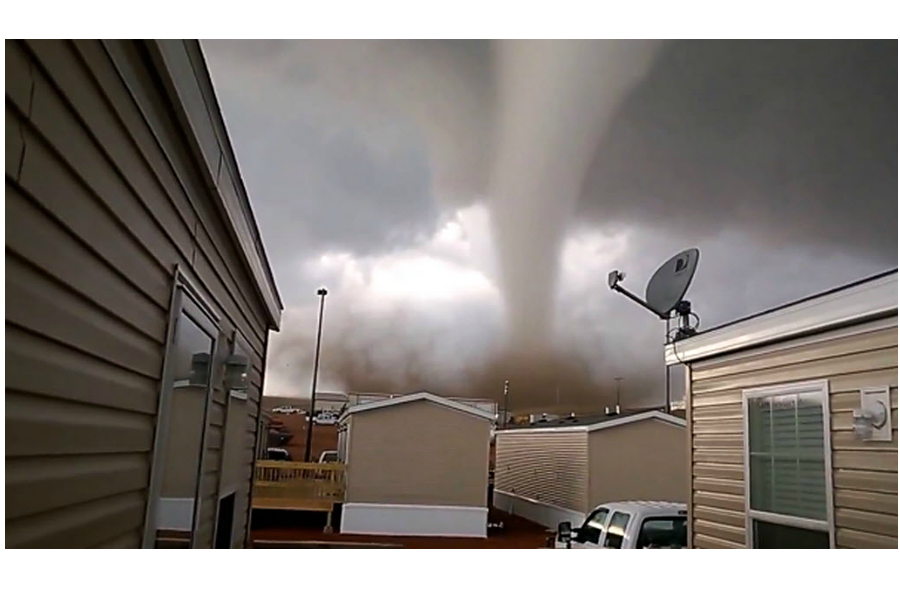Is climate change behind the rise in extreme tornado outbreaks?
Loading...
As global temperatures warm, climate scientists expect to see more tornadoes reaching their long, swirling bodies down to Earth. But the data isn't exactly cooperating in a straightforward manner.
Scientists have reported that, over the last 50 years, the average number of tornadoes that touch down in the United States each year has not risen. But analysis of this data suggests that the most extreme outbreaks, when several twisters appear as part of a single weather event, are on the rise.
Surely climate change is playing a role in the rise of those extreme events, a team of researchers at Columbia University expected. But when they analyzed the data they didn't find the signs they expected, they report in a paper published Thursday in the journal Science.
No, that doesn't mean climate change isn't behind the rise of extreme tornado outbreaks across the country, study lead author Michael Tippett, a mathematician at Columbia University, tells The Christian Science Monitor in a phone interview. "We're just saying that it's not playing the role that we expected."
There are two ingredients that make for conditions conducive to tornadoes, Dr. Tippett explains. One is the propensity of air to rise, called the convective available potential energy (CAPE), and the other is vertical wind shear. Warmer, moist air near the surface of the Earth particularly tends to rise, so climate projections predicted an increased CAPE with climate change and therefore more of one of the key ingredients for tornadoes.
As such, Tippett and his colleagues expected to see an increased CAPE in the environments where extreme tornado outbreaks were occurring. But when they dug into the data, that wasn't the case. In fact, wind shear seems to have increased.
"The lack of a change in CAPE that correlates with the change in tornadoes is a significant result," Harold Brooks, a researcher at the National Severe Storms Laboratory who was not involved in the research, writes in an email to the Monitor.
"Increases in CAPE are, in the convective storms world, the thing we’re most confident in as the planet warms. It’s a fairly direct connection between surface warming and higher CAPE. The fact that they can explain the tornado changes by storm relative helicity (related to shear) changes is, in one aspect, not surprising (it’s a much better predictor of whether a storm will make a tornado than CAPE is), but, in another aspect, difficult to explain. We don’t really have a good conceptual model for why high SRH values should increase as the planet warms."
Tippett agrees that his research poses more questions than it answers, particularly when it comes to the role global warming may be playing in tornado trends.
"One possibility is that there are aspects of climate change that we don't understand yet," Tippett says. "The other possibility is it's not climate change."
The data Tippett and his colleagues are working off might not be the full story, Charles Konrad, director of the Southeast Regional Climate Center who was not involved in the study, points out. The methods and technologies for cataloguing tornado events greatly improved in the 1960s and 1970s, a few decades into the time period they focus on.
"We don't have a clear grasp early in the period of tornado intensity or exactly how many tornadoes," he says in a phone interview with the Monitor.
Michael Mann, director of the Earth System Science Center at Pennsylvania State University who was also not involved in the research, disagrees. "The trend analysis in the tornado data seems sound, but not especially novel – the increase that is found is consistent with other previous work," he writes in an email to the Monitor.
But, Dr. Mann says, "the climate change interpretation is fatally flawed."
"We published an article in Science only last year showing that the simple procedures used by the current authors (assuming that the climate change component of a time series is reflected by a simple linear trend) are entirely unsound and produce profound artifacts when trying to separate anthropogenic trends from natural variability. In fact, we have published four articles demonstrating this, back to 2006," he writes.
So could this mean Tippett and his colleagues' conclusions that the CAPE is not rising are flawed? "Yep," Mann says.
One challenge with this data, Tippett says, is that climate trends are assessed on the scale of centuries, not decades. So 50 years is a relatively short period for looking at climate signals.
"To do that only using the data is very challenging, so we would like to move to using numerical models which simulate the environment" and allow scientists to manipulate the data to include or exclude climate change or other variables, he explains, "so we can try to isolate what's going on."








